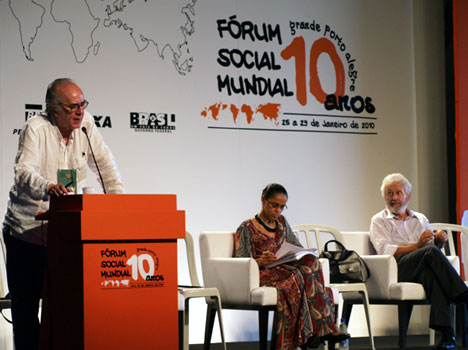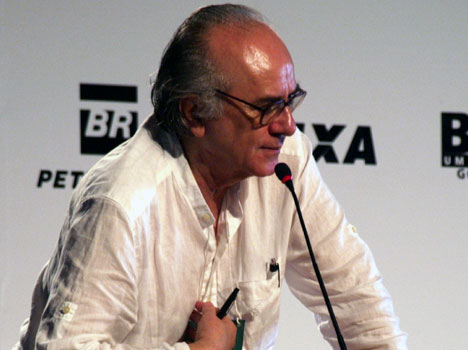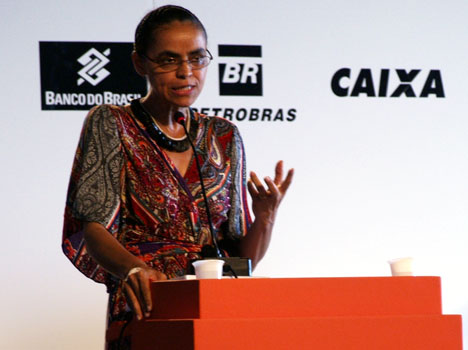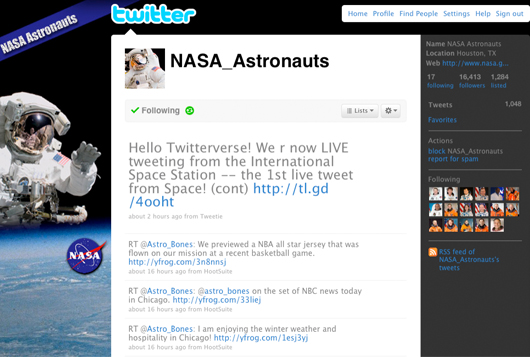Friday, January 29. 2010
World Social Forum - Day 4: "We've Reached the Age of Limits"
by Stephen Messenger, Porto Alegre, Brazil on 01.28.10

Photos: Stephen Messenger
After several days of meetings outlining the various threats posed by the current geopolitical and economic status quo, day four of the World Social Forum was largely dedicated to discussing the necessary solutions. Capitalism and the consumer culture it promotes were again the targets of criticism--and reiterated to be at the center of the looming crises of the 21st century. Climate change, growing disparities between rich and poor, and a laundry-list of social injustices were said to all be 'symptoms' of an unsustainable economic model which needs to be addressed to effect any real change--and a need for radical change in human behavior.
Current Trends Show Limits
In a meeting this morning to address the challenges of a "Sustainable Era," political economist Dowbor Ladislaus discussed the future projected by current trends in resource consumptions. One of his major concerns was with skyrocketing birthrates, articulating a need for population control to quell increasingly unsustainable cultural preferences. "Everyone wants to consume more meat, which means more methane and heat. We have to rethink it," he said.
Meanwhile, various speakers met to discuss how a new approach to governance could help ease the trends outlined by Ladislaus, with a new economic model based on sustainability. Getting more people involved and concerned for the environment is the key to moving towards a "post-capitalist horizon," said Portuguese sociologist Boaventura de Souza.
Every challenge to the current political hegemony will depend on a broad consensus. It is necessary to focus on democracy; A more advanced democracy, participatory democracy, a democracy Community.

Boaventura de Souza addresses an audience at the Forum.
Amit Sengupta of India's People's Health Movement took the urgency of creating more involvement a step further:
It is not enough to defeat capitalism and build a new hegemony. We must also protect humanity from extinction. Perhaps the human species can not survive capitalism. If we want to save the world, people who form the vast majority of the world, should be emancipated and allowed to achieve their minimum aspirations.
Governments Need to Change
Later on in the afternoon, former Brazilian Environmental Minister and current Senator Marina Silva continued the themes of reforming the way humanity is governed when she spoke before an audience of roughly 500 in Porto Alegre.
The current model of civilization is in crisis. We can no longer patch it. The economic model also shows the phenomenon of exhaustion. And the environmental crisis is exemplified by the current climate change.
Silva was accompanied by Oded Grajew, who founded the first

Former Brazilian Environmental Minister, Marina Silva.
Quality of Life Could Be Sustainable
According to Silva, the vast majority of people in the world are not interested in the economic prosperity that drives the wealthy few, but are rather seeking a sustainable quality of life. Sadly though, she said, that minority is capable of reaping cultural and environmental devastation in its pursuit.
She referenced the impact of past imperialism--noting that there were 5 million natives in Brazil in 1500, but five centuries later, there are only 700 thousand.
We must change the policy, change the planet and always with an ethical commitment, forging an alliance between the generations. Everything we do now will surely pass on to future generations. We reached the age of limits. We must begin the march towards transformation.
Check out coverage of Day 5 at the World Social Forum tomorrow.
More on the World Social Forum 2010
World Social Forum - Day 1: "Another World is Possible"
World Social Forum - Day 2: "Rich Nations, Clean Your Mess!"
World Social Forum - Day 3: "Earth Can't Sustain Capitalism"
-----
Via TreeHugger
Wednesday, January 27. 2010
Les vertus nouvelles de la circulation circulaire de l'information
Les temps changent. Et la notion de « circulation circulaire de l’information », qui était vicieuse dans le discours du sociologue
Cette idée d’inversion de la valeur attachée à cette notion n’est pas de moi. Je l’ai lue quelque part, mais je ne souviens pas où. Je la fais donc circuler sans référence à la source, ce qui rompt un peu, précisément, le flux de circulation circulaire. A me lire ici, on pourrait croire que j’en suis la source, alors que je ne suis qu’un « circulateur » [1]… ![]() [2]
[2]
Mais j’ai un autre bon exemple sous la main. Suivez, pas à pas, le processus de circulation circulaire :
- un billet de Mathieu, relevant une perle dans le rapport Gaymard sur le livre ;
- cité par Nicolas Vanbremeersch, sur Meilcour ;
- lequel est cité par narvic, ici-même ;
- lequel est cité par Hubert Guillaud, sur La Feuille.
Dans cette chaîne, chacun de ceux qui citent renvoie vers tous ceux qui ont cité précédemment. Et le tout suscite, à chaque citation, une « grappe » de commentaires « sur place » de la part du lectorat particulier de chacun des « citateurs ».
Chacun des « citateurs » commente l’information initiale et la « reformate » à destination de son propre lectorat, permettant ainsi d’en accroître la diffusion. Le processus se propage « en grappe » lui-aussi, chaque point de citation étant potentiellement le noeud d’une nouvelle propagation. Le message initial se métamorphose durant le processus (avec probablement des pertes et des gains d’informations au passage : des simplifications ou des enrichissements), mais c’est - en définitive - la diffusion globale du message initial qui est accrue par ce processus « en avalanche »…
Il y a là de quoi réfléchir. C’est vraiment, à mon avis, un nouveau mode de circulation de l’information qui s’illustre ici : une circulation de noeud en noeud, au sein d’un réseau « en grappes ».
Ce modèle n’a que peu de chose à voir avec celui de la circulation de l’information dans les réseaux « traditionnels » des médias (presse écrite, radio, télévision), comme je le suggérais récemment (cette question fait partie de « mon programme de travail sur ce blog »).
Une idée de là où je veux en venir, dans cet article de Alexandre Steyer [3] et Jean-Benoît Zimmermann [4] : Influence sociale et diffusion de l’information (15 pages, en .pdf). Résumé :
La notion de diffusion, quel que soit son objet, est centrale pour tout système ou construction sociale, car elle se trouve à la base de la mise en cohérence des comportements des individus ou de leurs représentations, donc de la coordination de leurs actions. L’idée, à l’origine de la notion de diffusion, est que les interactions entre individus sont le moteur principal de l’évolution de leurs comportements, croyances ou représentations. Notre démarche dans cet article est celle des réseaux d’influence sociale, dans lesquels l’agent est situé dans une structure de nature résiliaire où la progression de l’influence est contingente d’effets de cumul. Après avoir exposé les principes d’un modèle de diffusion en réseau, fondé sur une dynamique de cheminement de l’influence sociale, nous étudions la manière dont cette influence se propage sous la forme d’« avalanches », donnant par là une importance fondamentale à la structure du réseau. Nous analysons comment le bruit, généré par ces avalanches constitue une signature de la structure sociale et peut en retour contribuer, par effet d’apprentissage, à modifier cette structure et donc la dynamique [de] diffusion. Nous expliquons alors pourquoi émergent des courbes de diffusion « critiques » singulières, en loi de puissance, au lieu de la forme exponentielle des courbes de diffusion traditionnelles.
Quand la blogosphère joue à plein de cette « circulation circulaire » de blog en blog, qui permet la formation d’effets de diffusion « en avalanche », les médias en ligne, dans leur logique de sites « portails de l’information », de « sites de destination », ne sont pas en mesure de le faire. Ils ne sont plus qu’un maillon dans une chaîne, et c’est la chaîne - non plus le média - qui assure la diffusion en ligne. Les journalistes n’ont pas encore pris conscience de cette nouveauté et ne s’y sont pas encore réellement adaptés : s’ils veulent jouer un rôle dans la diffusion de l’information, c’est dans la dimension sociale d’internet que ça se joue, c’est à dire hors de leur site et après la mise en ligne. C’est ce qui me pousse à penser que l’avenir du journalisme en ligne est dans l’immersion dans les réseaux sociaux du net, ce qui est une autre aspect de la question déjà posée précédemment : Les sites d’info doivent-ils migrer sur Facebook et dans les blogs ?
On va en reparler sur ce blog… ![]()
-----
Via Novövision
Personal comment:
Un commentaire très à propos par rapport à la nature même de ce blog de "veille" (celui de fabric | ch). J'aime assez l'idée et l'image d'"avalanche informationnelle", qui serait donc constituée par la masse des "reblogs" et autres "reposts" ou citations.
Merci à Nicolas Besson pour le lien.
Time Is The New Space: Moments, Not Memos
from 10 Minute Sprint from 140 Characters Conference: Social Business
We are not sharing space online, although it the conventional wisdom says we are. We are sharing time. Time has become a shared resource.
Our time is increasingly not our own, in a good way, as we move into a streamed model of connection.
Individual time becomes less of a reality, and a shared thread of time will become the norm -- shared with those that are most important to you and those that reciprocate. This will change the basic structure of work.
Time is increasingly less linear, less mechanical; but more subjective and plastic.
Individuals will choose to trade personal productivity for connectedness, as voices in the stream ask for help, pointers, and introduction. Connectedness will trump other obligations, specifically timeliness.
I want to build on one aspect of this topic: to the degree that we rely on real-time streaming as the basis of our work interactions, we will sense that we are sharing time, not documents, or other artifacts. Interaction in real-time forms the context of our interactions, and displaces many prior social objects.
In particular, this means the end of documenting status is reports: moments are what we share, not memos.
The elements of the memo are atomized into a scattershot of micro status updates, which, like macro blogging before it, has thrown away the stucture of beginning, middle and end. We are always at the start, middle, and end. Not everything fits into a 140 character Twitter post, but long form writing won't necessarily look like memos, but a slightly slower stream made up of larger chunks.
In everyday, more prosaic terms, I am betting that the operational documents that flowed, sluggishly, through the interoffice mail of companies in the '90s, and as email attachments in the '00s, will simply not be created in the '10s. Instead, people will simply aggregate others' streams -- both micro and macro -- ordered by time and topic. Or simply remain aware of what folks are doing in an ambient way, sharing time. A fully streamed world, not batched.
-----
Via /Message
Tuesday, January 26. 2010
Whole Earth Catalog Neoncampobase
*You throw your bread on the water, and… well, you never can tell, ladies and gentlemen.
WHOLE EARTH CATALOGUE
Video selection for the series “Playlist”, Neoncampobase, Bologna (Italy)
http://www.neoncampobase.blogspot.com/
Opening: January 27, 2010
Curated by: Domenico Quaranta (http://domenicoquaranta.com).
Founded by the American writer Stewart Brand in 1968, the Whole Earth Catalogue (WEC) was a catalogue of tools that was regarded as a bible by the counterculture generation – that is, by those who shaped the techno-cultural environment we are living in. Published regularly until 1972 and sporadically until 1998, it definitely died with the rise of the Web, of which it is considered a conceptual forerunner by people such as Steve Jobs (founder of Apple) and Kevin Kelly (founder of Wired). WEC was conceived as an “evaluation and access device” meant to bring power and knowledge to the people. It featured excellent reviews of books, maps, professional journals, courses, and classes, along with objects of any kind, from gardening tools to computers. Everybody could submit a review for the catalogue.
Like the WEC reviewers, the artists in this exhibition are contributing to a shared resource; like them, they love their tools and, like them, they are interested in understanding the world as a whole. What did change, in the meantime – and mostly thanks to the WEC generation – is the world itself.
These artists – WE – live in a world in which media don’t just reproduce reality, nor just simulate it, in Baudrillardian terms: they shape reality, improve it, sometimes they build parallel worlds in which we can spend our time. They redesign our way to live, to think, to make and enjoy culture, to eat, to sleep, to die. And to think about God.
These artists use simple tools and editing tricks in order to comment on the current status of the image, to talk about themselves, to edit found material and to improve its meaning; they explore cultures and habits in order to sample, remix and comment them; they use and abuse technologies; they export metaphors, practices, aesthetics and narratives to other situations. This may sound weird if you are not living in their same time slice, but please – don’t call them formalists. They are not working within a medium: they are working within a media-implemented reality. They are realists, in the only way that realism makes sense nowadays.
This peculiar realism can bring somebody to go back to when everything started. Notoriously, psychedelic drugs played an important rule in the beginning of digital culture. Without Sun, by Brody Condon, is a mesh-up of various found videos of individuals on a psychedelic substance. Why do people broadcast these materials? Do these “out of the body” experiences have any relationship with other now common forms of projection of the self, such as online videogaming? Some artists, such as Cory Arcangel or Oliver Laric, are interested in the conceptual consequences of technologies, and on the way they are updating fundamental concerns of our culture; others, such as the duo AIDS-3D, explore how technologies are increasingly affecting our spiritual life. In their own words, they want to make “the intangible magic of technology visible”. Not necessarily trough technologies themselves: Constant Dullart’s video, for example, turns Youtube’s “loading” animation into a suggestive, hypnotic object using light and styrofoam balls.
This concern with magic and transcendence is shared by many of the artists on show, from Petra Cortright to Damon Zucconi, from Harm Van den Dorpel to Martin Kohout. In their hands, a video filter can become the best way to explore how consistent the outer world is, and how consistent we are. It can become the best way to get a better knowledge of the world we live in, whatever we may mean with this word.
Lavori selezionati / Selected works:
AIDS-3D (Daniel Keller & Nik Kosmas, US/DE), Motion Capture Dance, 2008. Video, 08.34 min. Courtesy Gentili Apri, Berlin. Online at http://www.aids-3d.com/motioncapture.mov.
Cory Arcangel (US), Drei Klavierstücke op. II – I, 2009. Video, 04.21 min. Courtesy Team Gallery, New York. Online at http://www.beigerecords.com/cory/Things_I_Made/DreiKlavierstucke.
Brody Condon (US), Without Sun, 2008. Video, 15.12 min. Courtesy Virgil De Voldere, New York. Online at http://www.tmpspace.com/video/WithoutSun.mov (excerpt).
Petra Cortright (US), Das Hell(e) Modell, 2009. Video, 03.41 min. Online at http://petracortright.com/das_helle_modell/das_helle_modell.html.
Paul B. Davis (UK/US), Compression Study #4 (Barney), 2007. Video, 02.49 min. Courtesy Seventeen Gallery, London. Online at http://www.youtube.com/watch?v=CWG5jqzYsEI.
Constant Dullart (NL), Youtube as a Sculpture, 2009. Video, 00.33 min. Online at http://www.youtube.com/constantdullaart.
Martijn Hendriks (NL), Untitled (12 glowing men), 2008. Video, 04.10 min. Online at http://www.12glowingmen.com/.
Jodi (BE/NL), Mal Au Pixel, 2009. Video, 01.14 min. Courtesy Gentili Apri, Berlin. Online at http://www.youtube.com/watch?v=KE8VIKXnsQ0.
Martin Kohout (CZ/DE), Close Up, 2009. Video loop, 03.11 min. Online at http://www.martinkohout.com/new/close-up/.
Oliver Laric (DE), Aircondition, 2006. Video, 01.59 min. Courtesy Seventeen Gallery, London. Online at http://www.oliverlaric.com/airconditionvideo.htm.
Les Liens Invisibles (IT), Too Close to Duchamp’s Bicycle, 2008. Video loop, 02.14 min. Online at http://www.lesliensinvisibles.org/too-close-to-duchamps-bicycle/.
Miltos Manetas (GR/UK), King Kong After Peter Jackson, 2006. Video, 03.05 min. Online at http://www.youtube.com/watch?v=cNMkjWpdC4c.
Pascual Sisto (US), No strings attached, 2007. Video, 01.30 min. Online at http://www.pascualsisto.com/projects/no-strings-attached/.
Paul Slocum (US), You’re Not My Father, 2007. Video, 04.05 min. Online at http://turbulence.org/Works/notmyfather/.
Harm Van den Dorpel (NL), Resurrections, 2007. 3 animated found photos, 04.18 min. Online at http://www.harmvandendorpel.com/work/resurrections.
Damon Zucconi (US), Colors Preceding Photographs (woodshed), 2008. Video, 00.35. Courtesy Gentili Apri, Berlin. Online at http://damonzucconi.com/uploads/Video/woodshed_w.mov.
Related Links:
Personal comment:
I've only heard recently of this "Whole Earth Catalogue" (yet another origin of the web), while looking at the "Das Netz" movie from Lutz Dammbeck. Here it comes back in a video show. It looks interesting as it is deeply rooted into californian counter culture that could also be pinpointed as "yet another --60ies-- root" for the web!
Monday, January 25. 2010
First tweet from space

That’s one small tweet for man, one giant tweet for mankind.
The virtual realm has physically expanded once again as Timothy Creamer a.k.a. Astro_TJ made Twitter history by being the first person to tweet live from space.
Quote: twitter.com/NASA_Astronauts: “Hello Twitterverse! We r now LIVE tweeting from the International Space Station — the 1st live tweet from Space! (cont)“
-----
Via NextNature
Personal comment:
To consider in relation with the "Deep Space Network" or rather the "Deep Space Internet". Then, it's still just a tweet, we are waiting for more!
fabric | rblg
This blog is the survey website of fabric | ch - studio for architecture, interaction and research.
We curate and reblog articles, researches, writings, exhibitions and projects that we notice and find interesting during our everyday practice and readings.
Most articles concern the intertwined fields of architecture, territory, art, interaction design, thinking and science. From time to time, we also publish documentation about our own work and research, immersed among these related resources and inspirations.
This website is used by fabric | ch as archive, references and resources. It is shared with all those interested in the same topics as we are, in the hope that they will also find valuable references and content in it.
